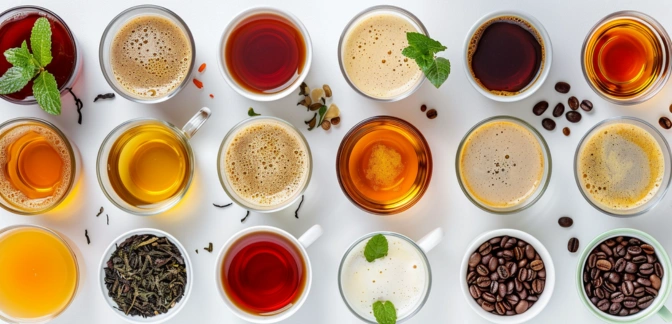Green Tea — Nutrients, Health Benefits, And Shopping Tips

Written by Listonic Team
Last update on September 4, 2024
Nutrition facts
Nutrition facts
Amount per 100 g
Calories
🔥 1 kcal
| Nutrition per: 100 g | Value | % Daily Value* |
|---|---|---|
| Carbs | 0 g | - |
| Fiber | 0 g | - |
| Sugars | 0 g | - |
| Glycemic Index | 15 | - |
| Protein | 0 g | - |
| Sodium | 3 mg | 0.13% |
| Total Fat | 0 g | - |
*The % of Daily Value (DV) tells you how much a nutrient in a serving of food contributes to a daily diet. 2,000 calories a day is used for general nutrition advice.
1
🍏 Low-Calorie Foods
15
🟢 Low Glycemic Index
Did you know?
Health benefits
- Rich in antioxidants such as catechins and polyphenols, which help protect the body from free radicals and reduce inflammation.
- May support heart health by improving cholesterol levels and blood pressure.
- Enhances mental alertness and focus due to its caffeine content.
- May aid in weight management by boosting metabolism and increasing fat burning.
- Supports immune function with its antimicrobial properties.
Health risks
- Potential for caffeine-related side effects such as insomnia, increased heart rate, or anxiety, particularly when consumed in large quantities.
- Risk of interactions with medications particularly blood thinners, as green tea contains compounds that can affect blood clotting.
- Potential for digestive irritation such as acid reflux or stomach discomfort, particularly in individuals sensitive to acidic foods or drinks.
- Potential for liver toxicity in rare cases, particularly when consuming large amounts of green tea extract supplements.
How to choose green tea
Quality green tea should have a vibrant green color and consist of whole leaves that unfurl when steeped. It should have a fresh, grassy aroma and a clean taste. Brew the tea to see it forms a pale green infusion.
Steer clear of green tea that is overly bitter or has a brownish color, as it may have been over-processed or stored improperly. Good green tea should taste refreshing and slightly sweet, with a delicate flavor profile.

How to store green tea
Green tea should be stored in an airtight container in a cool, dark place. A pantry or cupboard is ideal to preserve its delicate flavor and aroma. Properly stored, green tea can last up to a year.
Heat and light can degrade the quality of green tea, causing it to lose its flavor. It's best to keep it away from strong odors, which it can absorb. Ensuring the container is sealed tightly helps maintain its freshness, providing a delightful tea experience.
✅ Extra Tip
How long does it last?
Green tea can last for 6-12 months when stored in an airtight container in a cool, dark place. For the best flavor, consume it within these time frames. Proper storage away from light, heat, and moisture is essential to maintain its quality.
What to do with leftovers?
Leftover green tea can be used in a variety of culinary and non-culinary ways. In the kitchen, green tea can be enjoyed as a hot or cold beverage or used as a base for smoothies, iced teas, and cocktails. Brewed green tea can also be used to flavor sorbets, cakes, and other desserts, adding a subtle, earthy flavor.
Beyond drinking, green tea has several practical uses. The brewed and cooled tea can be used as a natural toner for the skin, helping to tighten pores and reduce redness. Green tea bags can be applied to the eyes to reduce puffiness and dark circles. Additionally, green tea can be used as a natural hair rinse to add shine and help soothe the scalp. Green tea leaves can be used in potpourri or sachets to add a fresh scent to your home, or they can be sprinkled in the garden as a natural fertilizer that helps enrich the soil.
👨⚕️️ Medical disclaimer
Discover products from other categories
Listonic Team
Fact-checked
Our editorial team checked this article to make sure it was accurate at the time of publishing it.
Get the top-rated shopping list app

green tea
1 piece







